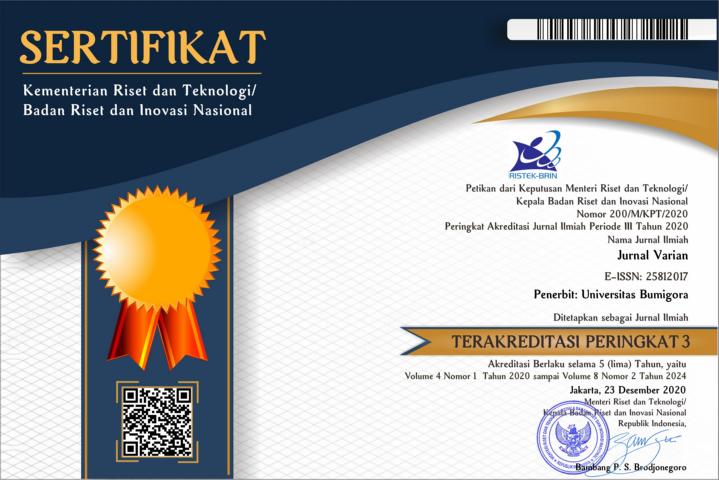Mapping of Village Population Profile with Schistosomiasis Cases Using Clustering Large Applications
Abstract
Schistosomiasis is a tropical disease caused by Schistosoma mansoni (intestinal schistosomiasis) and Schistosoma haematobium (urogenital schistosomiasis). Schistosomiasis in Indonesia is endemic to Central Sulawesi and is commonly found in the Napu Valley and Bada Valley areas, which are administratively included in Poso District and Sigi District. One approach to obtain information on schistosomiasis endemic areas is by mapping the population profile of villages with schistosomiasis cases. This mapping is intended to provide an overview of the social and demographic conditions of villages with schistosomiasis cases. One of the many analysis methods that can be used is cluster analysis. Cluster analysis is a method for grouping data based on the extent of their similarities. Data with similar characteristics will be grouped together, while data with different characteristics will be placed in different groups. Among several types of methods in cluster analysis is Clustering Large Application (CLARA). CLARA is a clustering method which is more robust to unusual data and can be applied to handle large volumes of data. The results of this study are obtained two optimum clusters, each possessing distinct characteristics as determined by Schistosomiasis cases indicators. Cluster 1 with low schistosomiasis cases and cluster 2 with high schistosomiasis cases.
References
Vektor Penyakit, 11(2):49–60. https://doi.org/10.22435/vektorp.v11i2.7160.49-60.
Deol, A. K., Fleming, F. M., Calvo-Urbano, B., Walker, M., Bucumi, V., Gnandou, I., Tukahebwa, E. M., Jemu, S., Mwingira, U. J.,
Alkohlani, A., et al. (2019). Schistosomiasisassessing progress toward the 2020 and 2025 global goals. New England Journal of
Medicine, 381(26):2519–2528. https://doi.org/10.1056/nejmoa1812165.
Direktorat Pencegahan dan Pengendalian Penyakit Tular Vektor dan Zoonotik Kementrian Kesehatan RI (2020). Pengendalian coronavirus disease (covid-19). Kemenkes RI.
Erlan, A., Widjaja, J., Nur Widayati, A., Maksud, M., Tolistiawaty, I., Mustafa, H., et al. (2020). Implementasi model bada dalam
pengendalian schistosomiasis di desa lengkeka, kecamatan lore barat, kabupaten poso, sulawesi tengah implementation of the bada
model in schistosomiasis control in lengkeka village, kecamatan lore barat, poso district, central sulawesi. Buletin Penelitian
Kesehatan, 48(3):199–208. https://doi.org/10.22435/bpk.v48i3.3246.
Fadillah, W. N. (2023). PENGEMBANGAN SISTEM INFORMASI GEOGRAFIS UNTUK PEMETAAN PENYAKIT DBD DI SUMATERA UTARA MENGGUNAKAN METODE PARTITIONING AROUND MEDOIDS. PhD thesis, UNIMED. https://doi.org/10.
35580/jmathcos.v6i2.52350.
Faujia, R. A., Setianingsih, E. S., and Pratiwi, H. (2022). Analisis klaster k-means dan agglomerative nesting pada indikator
stunting balita di indonesia. In Seminar Nasional Official Statistics, volume 2022, pages 1249–1258. https://doi.org/10.34123/
semnasoffstat.v2022i1.1511.
Fitrayana, P. R. and Saputro, D. R. S. (2022). Algoritme clustering large application (clara) untuk menanganidata outlier. In Prisma,
Prosiding Seminar Nasional Matematika, volume 5, pages 721–725.
Gordon, C. A., Kurscheid, J., Williams, G. M., Clements, A. C., Li, Y., Zhou, X.-N., Utzinger, J., McManus, D. P., and Gray, D. J.
(2019). Asian schistosomiasis: current status and prospects for control leading to elimination. Tropical medicine and infectious
disease, 4(1):40. https://doi.org/10.3390/tropicalmed4010040.
Marsita, D. (2021). CLUSTERING DAERAH RAWAN GEMPA DI SUMATRA BARAT MENGGUNAKAN METODE CLUSTERING
LARGE APPLICATIONDAN METODE DENSITY-BASED SPATIAL CLUSTERING OF APPLICATIONS WITH NOISE. PhD
thesis, UniversitasMuhammadiyahSemarang.
Muslim, A. B. (2018). Cluster analysis using clara method for data with outlier.
Nahdliyah, M. A., Widiharih, T., and Prahutama, A. (2019). Metode k-medoids clustering dengan validasi silhouette index dan
c-index (studi kasus jumlah kriminalitas kabupaten/kota di jawa tengah tahun 2018). Jurnal Gaussian, 8(2):161–170. https:
//doi.org/10.14710/j.gauss.v8i2.26640.
Nurwidayati, A., Frederika, P. P., Sudomo, M., et al. (2019). Fluktuasi schistosomiasis di daerah endemis provinsi sulawesi tengah
tahun 2011-2018. Buletin Penelitian Kesehatan, 47(3):199–206. https://doi.org/10.22435/bpk.v47i3.1276.
Rifa, I. H., Pratiwi, H., and Respatiwulan, R. (2019). Implementasi algoritma clara untuk data gempa bumi di indonesia. In Seminar
& Conference Proceedings of UMT. https://doi.org/10.31000/cpu.v0i0.1694.Sakinah, N., Saputra, W., Nurfitra, N., Satriani, S., and Junaidi, J. (2022). Analisis spasial penyebaran penyakit schistosomiasis
menggunakan indeks moran untuk mendukung eradikasi schistosomiasis di provinsi sulawesi tengah berbasis web dashboard.
Jambura Journal of Probability and Statistics, 3(2):120–127. https://doi.org/10.34312/jjps.v3i2.16580.
Supriyadi, E. et al. (2017). Perbandingan metode partial least square (pls) dan principal component regression (pcr) untuk mengatasi
multikolinearitas pada model regresi linear berganda. Unnes Journal of Mathematics, 6(2):117–128. https://doi.org/10.15294/ujm.
v6i2.11819.
Towidjojo, V. D., Nurhafizhah, A. S., and Mardin, S. (2023). Faktor-faktor yang berhubungan dengan perilaku pencegahan
schistosomiasis pada masyarakat desa kaduwaa napu kabupaten poso. Promotif: Jurnal Kesehatan Masyarakat, 13(1):22–27.
https://doi.org/10.56338/promotif.v13i1.3719.
Utami, D. S. and Saputro, D. R. S. (2018). Pengelompokan data yang memuat pencilan dengan kriteria elbow dan koefisien silhouette
(algoritme k-medoids).

This work is licensed under a Creative Commons Attribution 4.0 International License.


















